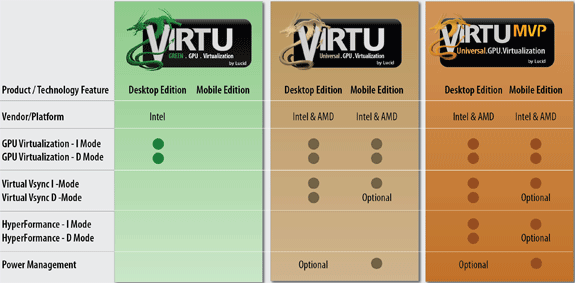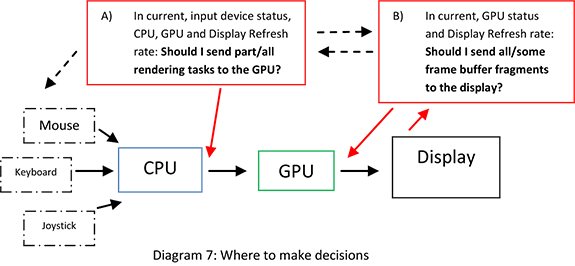IDF 2011: Lucid Announces Virtu Universal MVP Featuring HyperFormance Technology (Update)
by Ryan Smith on September 14, 2011 3:16 AM EST- Posted in
- GPUs
- Lucid
- IDF 2011
- Trade Shows
At the start of 2011 Lucid announced their Virtu software to go with Intel’s Sandy Bridge CPUs. With Virtu users would be able to use a discrete GPU and Sandy Bridge’s integrated GPU simultaneously in order to use the features of both GPUs. This normally meant either using a dGPU as the primary GPU while still being able to access Sandy Bridge’s QuickSync (D-mode), or using the iGPU as the primary GPU while having the dGPU power up and render frames to the iGPU when the dGPU’s capabilities were needed (I-Mode).
More recently in June at Computex they announced Virtu Universal. Virtual Universal added support for using Virtu with AMD’s integrated GPUs, and introduced the company’s Virtual Vsync technology for preventing screen tearing without using vsync.
Lucid has continued to work on Virtu since then, and finally at today’s IDF they’re announcing their latest rendition of Virtu: Virtu Universal MVP. Virtu Universal MVP adds Lucid’s latest technology, which the company is calling HyperFormance technology. Lucid is claiming that with HyperFormance they will be able to significantly improve I-mode rendering performance by “removing redundant rendering tasks”, or in essence they will be improving performance by rendering less.

So what exactly is HyperFormance? That’s a great question, and we don’t have a great answer. Lucid has decided to keep the mechanisms of HyperFormance under wraps for patent purposes, so what we have to work with amounts to a very high level overview. In this overview Lucid has made it clear here that the principle feature of HyperFormance is that it’s reducing the rendering workload on the dGPU by intercepting and removing some rendering tasks within a frame. This in turn would reduce input lag by either allowing a GPU to render a frame faster and move on to the next frame, or just hold off entirely until it's closer to a refresh cycle so that the rendered frame is not as old.
The long and short of it is that Lucid seems to have integrated the basis of Hydra – their largely ignored multi-GPU rendering technology – into Virtu, and are using Hydra’s ability to split up drawing commands to remove drawing commands heading to the GPU entirely. The unknown part of the equation is how Lucid is deciding what to remove. Based on what we’ve seen of Hydra it seems unlikely that this is a hidden surface removal technology, in which case it’s more likely that it’s an attempt to calculate and only render parts of an image that have changed from a previous frame – a GPU form of delta/inter-frame compression.

What’s also clear is that HyperFormance goes hand-in-hand with Lucid’s Virtual Vsync technology, which appears to do something like that (as with HyperFormance, they aren’t saying how Virtual Vsync works either). The significance here is that while HyperFormance would be looking at a frame based on draw commands, Virtual Vsync works off of a finished frame. So HyperFormance is getting some kind of feedback for future frames based on Virtual Vsync’s analysis of the completed frames.
Beyond this we know very little about the technology, or more importantly what the pitfalls may be. The immediate concern is that not rendering something could very result in the final composited image being wrong in some manner, or that doing all of this analysis may increase input lag more than a faster framerate decreases it. More interestingly though, because they need to analyze both draw commands and the rendered frame, HyperFormance only works in setups with multiple GPUs (i.e. iGPU + dGPU), as Lucid needs to be able to completely control the input and the output of the dGPU. So I-mode could potentially have less input lag than using just a discrete GPU with V-sync, and Lucid is promising just that. It certainly seems farfetched, but not impossible with the little information we have to work with.
In any case as Lucid has just announced Virtu Universal MVP, HyperFormance is not yet available for testing. Once Lucid makes it available for review it’s definitely something that bears following up on, so stay tuned.
Update: We had a chance to talk to Lucid about HyperFormance and Virtual Vsync in more detail, and have updated our article accordingly. One thing Lucid has made very clear is that while HyperFormance technically improves framerates, this is not the intention of the technology. Indeed it's largely a side effect of the fact that with HyperFormance the GPU is rendering some (or none) of a frame while still reporting to the CPU that the frame has been rendered and the buffers flipped.
The principle purpose of HyperFormance is to reduce input lag, and this is a logical extension of Virtual Vsync - if something is not going to be displayed (e.g. it will be an out of date frame by the time the next buffer flip comes around), why render it? Ultimately what Lucid is doing here is a creative workaround on updating the display without always waiting up to 16ms for a new refresh cycle with v-sync, and an even more creative workaround for the fact that modern GPUs typically have up to several frames in their rendering pipeline. The end goal is to display as new a frame as possible, as waiting for refreshes and having multiple frames in the rendering pipeline both contribute to input lag.
Of course it goes without saying that there are good reasons that modern GPUs have a frame pipeline, and this is primarily to smooth out the framerate so that it doesn't constantly fluctuate (creating a microstutter-like effect) and so that the CPU doesn't end up waiting on the GPU. Lucid contends that their solution can handle these issues without buffering additional frames - and thereby without increasing input lag - and it will be interesting to put this to the test once Virtu Universal MVP finally ships.










13 Comments
View All Comments
IceDread - Wednesday, September 14, 2011 - link
I do not want a product with Lucid tech, that is for sure. From all tests I've seen it's extremely rare that it performs better than a single graphic card does when mixing two different graphic cards. It's also not as efficient as the old tech used for sli or crossfire.Their idea is interesting but their execution is horrible.
So before I see new tests that proves that any of their tech is working nicely I do not want anything from that company.
Ben90 - Wednesday, September 14, 2011 - link
It is quite true that Hydra scaling with different cards is abyssal. It is also true that scaling with the same cards is not quite as efficient as SLI/Xfire. However I would much prefer it to a SLI/Xfire solution.The biggest problem with SLI/Xfire is latency. No matter how many cards you throw into your system, the individual frame rendering times stay the same. The only way to get benefits out of more cards is to render ahead using Alternate Frame Rendering. This introduces quite a bit of input delay. I cringe when I see people bragging about their Quad GPUs able to pump out 100+ FPS. That's a free 40ms of input delay just by itself. For someone who tries to get frame latency as low as possible, SLI/Xfire just isn't an option.
Enter Lucid's Hydra. While those 4 GPUs in the above situation might get 100FPS in SLI, they may only get 70FPS when running on Hydra. However, since all GPUs are working on one frame at a time, it only takes 14ms to render the frame. We just got 26ms of input delay cut.
If I were to build an absolutely no limits system, it would either have a single powerful GPU, or multiple GPUs on a Hydra chip. I won't touch SLI/Xfire until they can provide a competent SFR solution.
IceDread - Wednesday, September 14, 2011 - link
Sorry but no. Lucid has never been able to implement their ideas. Their implementation has always been nothing but a bust.Thus, I do not believe in them until it has been proven that they have a product that does what they claim to have it do.
About the problem with crossfire and sli and fps is also not true what you write. The problem that exists with SLI and Crossfire is micro suttering. That problems becomes less noticeable if the picture they work on take the same effort or when you have a high fps.
This link describes the problem fairly well.
http://www.pcgameshardware.com/aid,631668/Video-pr...
GTVic - Wednesday, September 14, 2011 - link
Yes, we get it, you don't want to buy products that don't work. Next ...These type of "I don't like this company", "their products are bad", "I won't buy them" comments are pointless. Just discuss the technology.
IceDread - Thursday, September 15, 2011 - link
The tech is what is being discussed, or rather the faulty tech. Where did you learn to read?LoneWolf15 - Monday, September 19, 2011 - link
"The tech is what is being discussed, or rather the faulty tech.*"*Citation needed.
I'm not saying you're wrong, but you're not right until you actually show me something that backs you up. Until then, your statement, to me, amounts to an opinion, not a fact.
BroderickAU - Friday, February 24, 2012 - link
Micro stuttering is indeed a problem with multi-GPU, but it's far from the only problem. What Ben90 said about input lag is correct.m.amitava - Wednesday, September 14, 2011 - link
Nice name I have to admit! :PATC9001 - Wednesday, September 14, 2011 - link
IceDread...it took 20 years to actually make the concept of a transistor work...a good thing people like you were not working on that project!I'm pumped lucid is continuing to move forward with their concepts. Yes they don't work like they need to but they;re making progress, it's called a paradigm shift and it takes time and a ton of work...sometimes the fruits of their labor turn into something totally different (i.e. maybe thier hydra approach fails but this new approach does and it was developed from the hydra technology...it's just how innovation works)
ayersmj - Thursday, September 15, 2011 - link
I for one would just be happy if they'd update their HydraLogix driver for my Crossfire IV Extreme board. It hasnt had a driver update since March and wont work with newer NVidia drivers without one.Can they work on that now please?